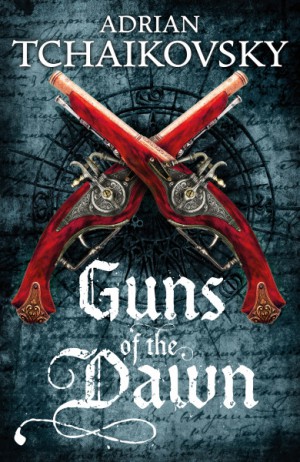 Well, it’s out February 12th this year, and I started writing Guns of the Dawn in… it must have been the late 1990’s.
Well, it’s out February 12th this year, and I started writing Guns of the Dawn in… it must have been the late 1990’s.
I mean, obviously there were some distractions along the way. I seem to recall something to do with a ten-book series about insect-people. It’s amazing what just slips in when your attention’s on other things.
Seriously, though, way back when, after the insect-kinden were conceived as an RPG setting in university – but not that long after – and long before I actually scored a hit with this writing lark, I had the idea for a book about a woman who goes to war, following in the footsteps of her brother. She wouldn’t go dressed up as a man, but on her own merits. The setting was decidedly regency-y. Some of the current plot was certainly vaguely planned out. Back then, it didn’t get very far.
I was going through a very choppy period in my writing about then. I’d finished about seven complete manuscripts over the years, and each one had been slapped down by publishers and agents, or just vanished into the void, because that’s my thing, as far as “How did you get to become a writer”; to wit, the long way, the traditional, painstaking and slowly soul-destroying way of writing things and not getting anywhere. It’s a varied and gallant siblinghood. There are a lot of us out there.
But right about then, I wasn’t even finishing manuscripts. I can still remember a number that I started on (and you always tell yourself you’ll go back) and got to, maybe, chapter 7 or so, and then just… ran out of steam. The ideas that seemed so firecracker at the outset had run out of bang-fatoom by then, and I ran out of momentum. Later, I’d start on the next, and then the next. In the midst of this lack of self-confidence and general malaise came the first inklings of Guns of the Dawn.
It came first as a single scene: a door opens and outside there’s a band of soldiers, young and brave, and they’ve come for one of the household, to take him off as one of their own. It’s not a tragic scene in and of itself, but there’s something of that dawn mist behind them, something of the way the light touches their pale faces, and you know it won’t end well.
And I knew the story wouldn’t be about the man who went, but about the woman that stayed behind.
I wrote that one chapter – I don’t have the file anymore since my antiquated Amstrad popped its tinny little clogs a while ago, but I think the pertinent section of chapter 2 of Guns is pretty close, in content and in feel, to that original offering.
And then… then I couldn’t make it go any further, and so it fell with all the other piecemeal projects, and I went on to something else. But of all those ideas – some far more fantastical – it was that one which stayed with me. Year on year, book after book, rejection after rejection (and I’m aware I’m milking the self-pity here. Picture me with hand pressed delicately to forehead as the angst of it racks me), but that scene, and the longer story hidden within it, just wouldn’t let go.
Fast forward to around 2004, before I started on Empire in Black and Gold. I knew by then that I wanted to do something big and final – the insect-kinden were already filling my head with a distant buzzing; Stenwold and Tisamon were already breaking out of their 12-year cocoons, stretching and trying to remember who they were. And yet…
Even as the shadow of their wings was falling over me, I sat down and began to work on that old idea. The working title was The Woman’s War, and right from the start I knew what was wrong with the original attempt: as simple as starting in the wrong place. I needed to start with Emily already holding the (soon to be titular) gun, there in the fetid swamps of the Levant front. I think what I learned then was that the very geography of the place was a character, whose absence had been invisibly but keenly felt before. The privations of the heat, the humidity, the close air and the biting flies cemented something, and I got out a creditable first draft before turning my attentions to the encroaching Wasp Empire, and all that came after.
So it was natural that, as War Master’s Gate went to press, I should go back and re-read what I had done, without any particular expectations. Certainly it needed work – my writing style and ability has most definitely advanced while I accompanied the kinden on their campaigns. I undertook an enormous amount of polishing, I sent Woman’s War/Guns of the Dawn out to beta-readers, and I re-wrote large chunks of it. I reworked some characters, changed others beyond recognition to bring you the book you (and here I’m being hopeful) surely have to hand even now (No? Well, you know, all good bookshops and all that…). But the original idea, that long-conceived idea, is still very much the soul of the book. As noted, there were a lot of fallen leaves in those late 90’s writing sessions, plenty of ideas that seemed golden at the time but fell away and were left in the dust. There is only one book – specifically conceived and started as a book – which has never let go of me, and has shadowed me all the way to the present day. It is Emily Marshwic’s book, the story of her war for her king, her country and her truth, however hard to reconcile those may be. I am happier than I can say that, after all her perseverance (a character trait that appears to have preceded her actual realisation as a character), she is finally seeing the light of day.
***
Guns of the Dawn is due to be published in the UK by Tor on February 12th, 2015. Here’s the synopsis:
Denland and Lascanne have been allies for generations, but now the Denlanders have assassinated their king, overthrown the monarchy and marched on their northern neighbour. At the border, the war rages; Lascanne’s brave redcoats against the revolutionaries of Denland.
Emily Marshwic has watched the war take her brother-in-law and now her young brother. Then comes the call for more soldiers, to a land already drained of husbands, fathers and sons. Every household must give up one woman to the army and Emily has no choice but to join the ranks of young women marching to the front.
In the midst of warfare, with just enough training to hold a musket, Emily comes face to face with the reality: the senseless slaughter; the weary cynicism of the Survivor’s Club; the swamp’s own natives hiding from the conflict.
As the war worsens, and Emily begins to have doubts about the justice of Lascanne’s cause, she finds herself in a position where her choices will make or destroy both her own future and that of her nation.
Adrian Tchaikovsky is also the author of the incredible, ten-book Shadows of the Apt epic fantasy series, which includes: Empire in Black and Gold, Dragonfly Falling, Blood of the Mantis, Salute the Dark, The Scarab Path, The Sea Watch, Heirs of the Blade, The Air War, War Master’s Gate, Seal of the Worm

This looks AWESOME! And that COVER! Yes very much looking forward to this one.
LikeLiked by 1 person
Doesn’t it just? Can’t wait to read this novel. 🙂
LikeLike
[…] Tchaikovsky (2012); Guest Posts on “Nine Books, Six Years, One Stenwold Maker” and “The Art of Gunsmithing — Writing Guns of the Dawn“; Excerpt from Guns of the […]
LikeLike
[…] with Adrian Tchaikovsky; Guest Posts on “Nine Books, Six Years, One Stenwold Maker”, “The Art of Gunsmithing — Writing Guns of the Dawn“; an Excerpt from Guns of the Dawn; Reviews of Guns of the Dawn, Empire in Black & Gold […]
LikeLike
[…] Adrian Tchaikovsky (2012); Guest Posts on “Nine Books, Six Years, One Stenwold Maker”, “The Art of Gunsmithing — The Writing of Guns of the Dawn“, and “”; Excerpt from Guns of the Dawn; Reviews of Empire in Black & Gold, Guns of […]
LikeLike
[…] Adrian Tchaikovsky; Guest Post on “Nine Books, Six Years, One Stenwold Maker“, “Art of Gunsmithing — Writing Guns of the Dawn” and “Looking for God in Melnibone Places: Fantasy & Religion“; Excerpt […]
LikeLike
[…] Adrian Tchaikovsky (2012); Guest Posts on “Nine Books, Six Years, One Stenwold Maker”, “The Art of Gunsmithing — Writing Guns of the Dawn“, “Looking for God in Melnibone Places: Fantasy & Religion” and “Eye of the […]
LikeLike
[…] with Adrian Tchaikovsky (2012); Guest Posts on “Nine Books, Six Years, One Stenwold Maker”, “The Art of Gunsmithing — Writing Guns of the Dawn”, “Looking for God in Melnibone Places: Fantasy & Religion” and “Eye of the Spider”; […]
LikeLike
[…] Adrian Tchaikovsky (2012); Guest Posts on “Nine books, Six Years, One Stenwold Maker”, “The Art of Gunsmithing — Writing Guns of the Dawn“, “Looking for God in Melnibone Places : Fantasy and Religion”, “Eye of the […]
LikeLike
[…] Adrian Tchaikovsky (2012); Guest Posts on “Nine Books, Six Years, One Stenwold Maker”, “The Art of Gunsmithing — Writing Guns of the Dawn“, “Looking for God in Melnibone Places” and “Eye of the Spider”; Excerpt […]
LikeLike
[…] with Adrian Tchaikovsky (2012); Guest Posts on “Nine books, Six Years, One Stenwold Maker”, “The Art of Gunsmithing – Writing Guns of the Dawn“, “Looking for God in Melnibone Places — Fantasy and Religion”, “Eye of the […]
LikeLike
[…] Adrian Tchaikovsky (2012); Guest Posts on “Nine Books, Six Years, One Stenwold Maker”, “The Art of Gunsmithing”, “Looking for God in Melnibone Places”, “Eye of the Spider”; Excerpt from […]
LikeLike
[…] “Looking for God in Melnibone Places”, “Eye of the Spider”, and “The Art of Gunsmithing: Writing Guns of the Dawn“; Excerpt from Guns of the Dawn; Reviews of Guns of the Dawn, Empire in Black & […]
LikeLike
[…] Adrian Tchaikovsky (2012); Guest Posts on “Nine Books, Six Years, One Stenwold Maker”, “The Art of Gunsmithing”, “Looking for God in Melnibone Places” and “Eye of the Spider”; Excerpt […]
LikeLike
[…] Adrian Tchaikovsky (2012); Guest Posts on “Nine Books, Six Years, One Stenwold Maker”, “The Art of Gunsmithing — Writing Guns of the Dawn“, “Looking for God in Melnibone Places — Fantasy and Religion”, and “Eye of […]
LikeLike
[…] Adrian Tchaikovsky (2012); Guest Posts on “Nine Books, Six Years, One Stenwold Maker”, “The Art of Gunsmithing: Writing Guns of the Dawn“, “Looking for God in Melnibone Places: Fantasy and Religion”, and “Eye of the […]
LikeLike
[…] with Adrian Tchaikovsky (2012); Guest Posts on “Nine Books, Six Years, One Stenwold Maker”, “The Art of Gunsmithing: Writing Guns of the Dawn”, “Looking for God in Melnibone Places: Fantasy and Religion”, and “Eye of the Spider”; […]
LikeLike
[…] with Adrian Tchaikovsky (2012); Guest Posts on “Nine Books, Six Years, One Stenwold Maker”, “The Art of Gunsmithing: Writing Guns of the Dawn”, “Looking for God in Melnibone Places: Fantasy and Religion”, and “Eye of the Spider”; […]
LikeLike
[…] with Adrian Tchaikovsky (2012); Guest Posts on “Nine Books, Six Years, One Stenwold Maker”, “The Art of Gunsmithing: Writing Guns of the Dawn”, “Looking for God in Melnibone Places: Fantasy and Religion”, and “Eye of the Spider”; […]
LikeLike
[…] with Adrian Tchaikovsky (2012); Guest Posts on “Nine Books, Six Years, One Stenwold Maker”, “The Art of Gunsmithing: Writing Guns of the Dawn“, “Looking for God in Melnibone Places: Fantasy and Religion”, and “Eye of the Spider”; […]
LikeLike